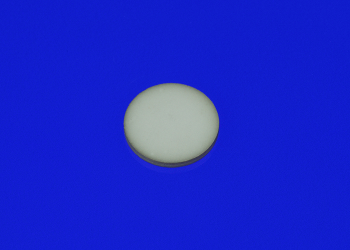Thanks to its excellent dielectric properties and a reliable surface finish, a high-quality alumina ceramic from Morgan Advanced Materials is now being successfully used in radiotherapy equipment for oncology treatment.
Deranox™ 970 is a high-density, non-porous and vacuum-tight material with a 97 per cent Al2O3 (aluminium oxide) content which provides excellent electrical insulation. It is frequently used in high-vacuum systems, in laser and microscope applications and as an insulator in medical and scientific equipment, and has now been specified as the sealing element for RF windows in radiotherapy equipment.

Acting as a mechanical seal at either end of the vacuum chamber through which electron beams pass in the radiotherapy process, RF windows maintain the integrity of the vacuum, allowing electrons to pass through while preventing both ingress of contaminants and vacuum leakage.
Yannick Galais from Morgan explains: “While most solutions for RF windows contain around 97 per cent alumina, it is the remaining 3 per cent that makes all the difference in dielectric performance. The alumina ceramic formulation of Deranox™ 970 provides a high dielectric constant – 9.85 and 9.84 at 2.8GHz and 2.9GHz respectively - and low loss tangent – 0.00109 and 0.00110 at 2.8GHz and 2.9GHz respectively. Externally tested and verified by an independent and fully accredited testing house to an internationally recognised standard, ASTM D2520, these properties contribute to excellent stability at high frequencies.
“Our sophisticated powder manufacturing processes provide excellent repeatability from batch to batch, between batches, which is a key parameter in tuning the nominal wavelength and beam frequency which will ultimately determine the performance of the of the radiotherapy machine. Our precision machining capabilities guarantee a consistent surface finish and flatness preventing RF reflectance and thus eliminating heat and leakage over time. Providing an impurity-free surface finish also improves the performance of the radiotherapy machinery by removing any potential for oxidation on the RF window.”
Using advanced simulation techniques and extensive modelling, Deranox™ 970 has been comprehensively tested for radiotherapy applications prior to the prototype stage to ensure its suitability – followed by in-depth real-life testing to ensure optimum performance within a very tight tolerance range. Developed alongside Deranox™ 970 for radiotherapy equipment, Morgan has also introduced a tailored moly-manganese metallising ink to facilitate the bonding process when the RF window is brazed to the body of the machine, creating the optimum seal and safeguarding the vacuum. As each RF window is individually designed for specific machinery, Morgan’s inks are custom formulated for each material grade. In addition to the ceramic, Morgan is able to supply the complete RF window sub-assembly including mounting flanges. Innovative design features allow Morgan to offer ceramic RF windows brazed inside the oxygen free copper (OFC) vacuum chamber.
Mr Galais continues: “RF windows made of Deranox™ 970 will last the lifetime of the radiotherapy equipment – generally 20 years plus. Within the highly time-sensitive oncology treatment pathway, disruption to therapy machinery is simply not an option and failure of an RF window will often require full replacement of the radiotherapy machine, at enormous cost to the hospital trust and causing unacceptable delays for patients. The purity of our Deranox™ 970 material, coupled with its reliable dielectric properties and Morgan’s extensive modelling and test processes, ensure a high-quality RF window solution with long-lasting performance.”
Morgan supplies a range of other components for radiotherapy and diagnosis equipment including high-voltage capacitors and feedthroughs. In radiology, Morgan’s ceramic to metal cathode insulators can be used as image amplifiers in CT and PET equipment, providing exceptional performance in a deep vacuum environment. Similarly, in MRI systems, brazed assemblies produced by Morgan are frequently used in high voltage, high power applications in conjunction with super conductivity coils.
Morgan also produces cutting edge oncology therapy couches. Providing optimised structural design using precise fibre orientation in lay-up, the couch uses advanced composites rather than metal components to help ensure that patients are positioned correctly for optimum treatment, enabling higher image quality and lower radiation doses.